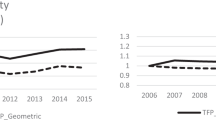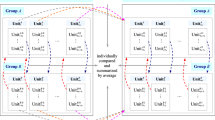Abstract
DEA is typically applied to cross-section data to analyze productive efficiency. DEA is infrequently applied to panel data to analyze the variation of productive efficiency over time, but when it is, the technique of choice has been window analysis. Here, we adopt a different approach to the use of DEA with panel data. Following the lead of Färe and others, we use DEA to construct a Malmquist index of productivity change, and we provide a new decomposition of the Malmquist productivity index. Our new decomposition allocates productivity change to change in productive efficiency, the magnitude of technical change, and the bias of technical change. We then propose an evaluation of managerial performance, not on the usual basis of static efficiency, but on the intertemporal basis of change in efficiency and adaptation to the bias of technical change. We illustrate our approach with an examination of the recent productivity change experience in Spanish savings banks.
Similar content being viewed by others

References
R. Banker, A. Charnes and W.W. Cooper, Some models for estimating technical and scale inefficiencies in Data Envelopment Analysis, Management Science 30(1984)1078–1092.
D.W. Caves, L.R. Christensen and W.E. Diewert, The economic theory of index numbers and the measurement of input, output, and productivity, Econometrica 50(1982)1393–1414.
A. Charnes, C.T. Clark, W.W. Cooper and B. Golany, A developmental study of Data Envelopment Analysis in measuring the efficiency of maintenance units in the U.S. Air Force, Annals of Operations Research 2(1985)95–112.
A. Charnes, W.W. Cooper, B. Golany, F.Y. Phillips and J.J. Rousseau, A multi-period snalysis of market segments and branch efficiency in the competitive carbonated beverage industry, in: Data Envelopment Analysis: Theory, Methodology and Applications, A. Charnes, W.W. Cooper, A.Y. Lewin and L.M. Seiford, eds., Kluwer Academic, Boston/Dordrecht/London, 1994.
D.L. Day, A.Y. Lewin, R. Salazar and H. Li, Strategic leaders in the U.S. brewing industry: A longitudinal analysis of outliers, in: Data Envelopment Analysis: Theory, Methodology and Applications, A. Charnes, W.W. Cooper, A.Y. Lewin and L.M. Seiford, eds., Kluwer Academic, Boston/Dordrecht/London, 1994.
D.L. Day, A.Y. Lewin and H. Li, Strategic leaders or strategic groups: A longitudinal Data Envelopment Analysis of the U.S. brewing industry, European Journal of Operational Research 80(1995) 619–38.
R. Färe, S. Grosskopf, B. Lindgren and P. Roos, Productivity developments in Swedish hospitals: A Malmquist output index approach, paper presented at a Conference on New Uses of DEA in Management, IC2 Institute, Austin, TX, USA, September 27–29, 1989, and in: Data Envelopment Analysis: Theory, Methodology and Applications, A. Charnes, W.W. Cooper, A.Y. Lewin and L.M. Seiford, eds., Kluwer Academic, Boston/Dordrecht/London, 1994.
M.J. Farrell, The measurement of productive efficiency, Journal of the Royal Statistical Society Series A, General 120(1957)253–281.
S. Malmquist, Index numbers and indifference surfaces, Trabajos de Estadistica 4(1953)209–42.
R.W. Shephard, Theory of Cost and Production Functions, Princeton University Press, Princeton, 1970.
Rights and permissions
About this article
Cite this article
Grifell-Tatjé, E., Lovell, C. A DEA-based analysis of productivity change and intertemporal managerial performance. Annals of Operations Research 73, 177–189 (1997). https://doi.org/10.1023/A:1018925127385
Issue Date:
DOI: https://doi.org/10.1023/A:1018925127385



